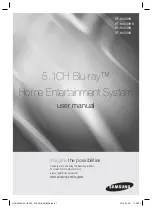
1
Introduction
Overview
The purpose of this manual is to discuss the circuitry in the 1999-2000
Sony projection television chassis. These chassis are the RA-3 and RA-
4A. Both of these chassis share circuitry with the RA-2 and/or RA-4 chas-
sis. There are previous training manuals that cover circuits in these mod-
els. The TVP-07 manual covers the RA-2 chassis and the TVP-08 manual
covered the RA-4 chassis. We will include excerpts from these training
manuals in the Appendix at the rear of this manual. Please take note that
some of the component designations may be different between the older
and newer chassis.
RA-3 Features
The following models use the RA-3 chassis:
KP-43T70
KP-53N74
KP-48V80
KP-46C70
KP-53S70
KP-53V80
KP-48S70
KP-61S70
KP-61V80
KP-48S72
Important Note:
The book will make reference to two distinct types of
RA-3 chassis, S and V. Since the T, C and N models are similar to the S
models, we will be referring to all of these models when the term S mod-
els is used unless otherwise noted. This is because the C and N models
have marketing differences and are only sold by certain dealers. The T
model is distinctive because it uses the tabletop design instead of the
standard slim line design.
All RA-3 chassis models contain the following features:
Flash Focus System
Steady Sound Auto Volume
Advanced Picture Stabilizer
Shading Compensation
2 Tuner PIP
Velocity Modulation Scanning
Free Layout PIP
Dynamic Focus Circuitry
Flash Focus
– One button system that aligns the horizontal and vertical
centering of the red, green and blue tubes. This system differs from pre-
vious Sony one touch systems in that it does not align the skew of the
colors only the centering.
Advanced Picture Stabilizer
- Maintains constant picture quality by re-
sponding more quickly during scene changes, especially sudden dark-to-
bright transitions, thereby reducing zooming effect, minimizing picture dis-
tortion and correcting blooming (poor focus).
Free Layout PIP
– Allows the PIP picture to be moved anywhere on the
screen instead of to just the designated corners.
Beside screen size, the table below shows the differences between the N,
S, T and V models:
C,N and S
T
V
Comb Filter
3 Line
3 Line
3D
High
Contrast
Screen
No
Yes
Yes
Audio Power
Output
15Wx2
15Wx2
20Wx2
Surround
Sound
Matrix
Matrix
Tru-Surround
PIP
Regular
Regular
Twin View
Center
Speaker
Input
No
No
Yes
Component
Video Inputs
1
1
2
3 Line Digital Comb Filter
– To improve color performance, uses digital
memory to evaluate three adjacent horizontal scanning lines at a time.
3D Digital Comb Filter
– Uses digital memory to compare each horizon-
tal line with the line above and below it and also with the corresponding
lines in adjacent frames.
Summary of Contents for KP 48S70
Page 42: ...APPENDIX 1 ...
Page 44: ...ii ...
Page 50: ...viii ...
Page 52: ...x ...
Page 54: ...xii ...
Page 55: ...xiii L601 T605 1 T604 1 IC651 IC653 CN653 1 IC655 RY601 T603 1 3 4 Hot Ground TVP07GBPS ...
Page 56: ...xiv IC655 CN653 CN507 IC652 IC653 IC601 R608 TVP07GPSTOP ...
Page 58: ...xvi ...
Page 60: ...xvii ...
Page 61: ...xix CN502 CN503 CN504 Q505 CN653 Q501 Q502 TVP GBVT ...
Page 62: ...xx T501 1 T502 1 Q505 L505 1 CN504 1 CN502 1 T504 CN503 1 Q502 Q501 TVP07GBHV ...
Page 64: ...xxii ...
Page 66: ...xxiv ...
Page 72: ...xxx ...
Page 74: ...xxxii ...
Page 76: ...xxxiv ...
Page 78: ...xxxvi ...
Page 79: ...APPENDIX 2 ...









































